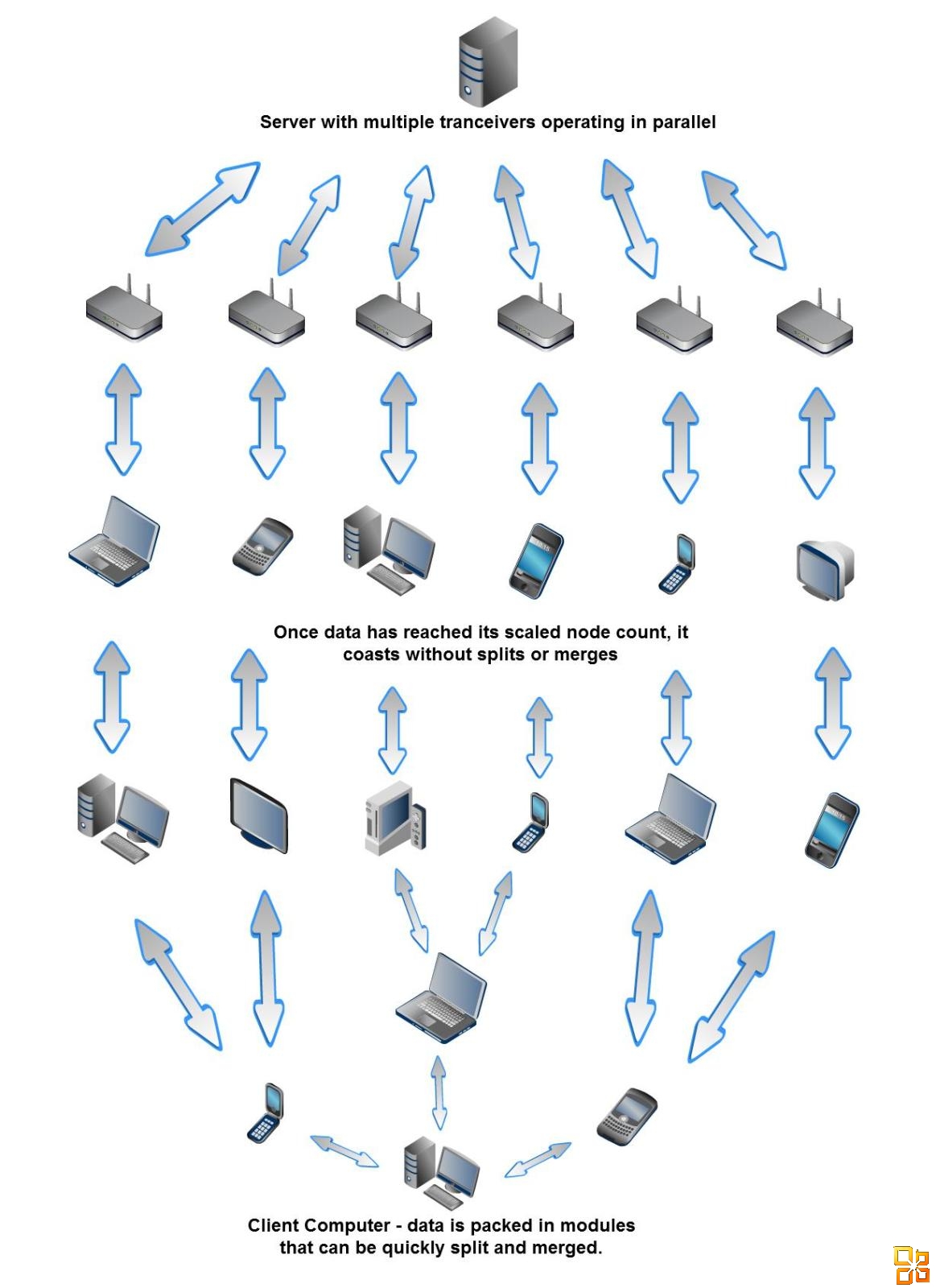
在读了关于权力下放的互联网一些答复的前一个线程 。感兴趣的人,我设计了一个约6个月前。我有它捎带有兴趣的人的文件和图-我没有时间投入到这个大项目,所以我想,我只是转储这段文字墙,介绍了想法。如果实际利率在此,我可能会继续工作,这里有一个形象的任何TL博士人: http://oi54.tinypic.com/fjgizp.jpg它是如何涉及到Bitcoin ?很简单-自动Bitcoins货币支付/正在访问网格中的节点越来越 payed。这是一种急功近利的故事为Bitcoin如果网络捕获。现在,这里的任何人想读的TL部分。这仅仅是一个引子,因为我有几个其他文件和图表,更多的技术细节 。PS - Chroud和ChroudNet的开发代号 是表示创造新的互联网和手机媒体,在解放和统一的网络基础设施,接口,和哲学模型 。它利用所有连接的设备的共享中继能力,形成一个人的,而不是服务提供商的基础设施-在一个分布式,并行的方式发送的跨连接的设备的数据。它也完全设计和优化云计算和远程处理。最重要的,ChroudNet是开放的批判,审查,和原型。基础设施 的一个特设的无线网状网的基础上,继电器在一个分布式,并行的方式的数据。它取代了当前的网络基础设施与人民群众的设备-手机,笔记本电脑,台式机,片,电视,游戏机,汽车,这样的例子不胜枚举,只会继续增长。由于连接的设备的增加密度和容量,长距离的高速无线数据传输(即- WiMAX)的增长模式,如具有很大的潜力。它也将保持其相关性,为今后多年的技术进展- “真正的”互联网2.0。无线确实有其自身固有的困难如丢包-但由于设计,如果一个数据包丢失的目标,在任何节点,检测和响应,是本地的,所以它的速度要快得多。建设网络也许这样一个非常雄心勃勃的的项目,因为这是建设网络从无到有的最大障碍。该网络将需要新的硬件和要求尝鲜。然而,一旦原型已经建成和标准开发的Ad - Hoc网络的本质是指网络可以启动本地:提供本地服务,如消息,文件传输,和一个城市或校园内的沟通- ,然后与其他连接网络,尽快为他们的海誓山盟的距离内达到 。为解决服务器的设计是这样的:一个更新的动态缓存和本地接口提供可视化的访问,解决系统内的服务器,基于物理位置(GPS)使用直接并行传输的流量,和服务器的标识(如一个全球性的唯一标识符)。服务器将定期播放他们的存在,它的位置和内容的通知连接的节点 。然后,当用户请求的信息,像猎犬嗅探犬使用全球定位系统和识别信息的服务器的数据包行为 。这样一来,设备是能够看到的正是服务和内容,在任何特定时刻。由于本地网络相互转化生长的,假设他们遵循一个标准化的模型,他们马上会合并成一个增量大的网络。前端(远程处理和客户端设备)ChroudNet功能将完全服务器端(或云端 )。简单的设备将作为收发器,用很少的本地计算能力 。成本和电池,通常会进入CPU和GPU的硬件,网络硬件和电池,而不是将。像OnLive的服务。前端将是一个全面综合的界面,在视觉上所有设备(基于开放标准)的一致。这将目前相当于语音,电视和互联网媒体,在所有连接东西的操作系统 。这种操作系统将提供两件事情:一个网络和媒体的的接口,以及作为一个统一的订阅模式,以纾缓商业内容的访问和支付。内容提供商将继续坚持一个通用的,标准化的订阅模式,计费供应商可以进一步在软件中定义的。这样,用户计费方式的选择-再分散的模式,使没有任何ChroudNet子服务的垄断媒体结构1)“ChroudCom” - 。语音和视频通信服务。2) “ChroudServe “ -流媒体软件为家庭和企业。每个服务可免费或商业,3)“ChroudPlay” -流游戏。每场比赛可免费或商用4)“ChroudChan” -典型的互联网,但作为网站高得多的功能将被处理和流媒体服务器端(无客户端的安全问题) 。试想3D交互式内容,可以运行本地代码。优势/动机没有服务供应商- ChroudNet删除从方程如Comcast和Verizon的服务提供商-包括所有相关的成本和监管网络的整合-语音,视频和数据网络之一。在分布式传输的高速上的所有设备的一切-因为设备是简单的接收和显示流,他们将能够处理所有类型的数据没有具体的数据,硬件的额外成本。没有调节/警务网-中性和通讯。没有电线-完全运行在本地周边,无线接入。忘记撕毁住宅用地,安装,和维护昂贵的电线。绿色-没有物理基础设施,有没有维修,集中的数据中心,或服务车。快速-分布式并行传输数据分解成小块,通过网络发送由本地设备的数量,有效地乘以你的连接速度。安全-在网络中的用户只有微小的零散件,不等同于任何本地经营。它不是,直到每一个片段达到您的计算机中收集数据变得有意义。适应性-基础设施的升级,如释放升级的设备简单。这意味着网络的增长驱动技术一样快速。没有一年(S)长时间的等待,撕毁和物理电缆内选定的城市。优化云-端计算-云边转移的大部分是从服务器上部署的数据,如流视频和游戏。服务器可以传输数百个自己的地方收发数据,在超过数百台设备并行行驶,仅在您的设备前的跳跃的汇合。300跳转300多台设备,每10英里半径的理论峰值,可能在一个单一的,10英里的无线传输时间跨了整个美国。进-随着无线传输速度和距离的增加与技术,以及越来越多的用户加入网络,速度和可用性成倍增长。可扩展性-网络不仅自动秤,其用户数量-它实际上变得更快(由于无源:有源器件的比例 )
原文如下:
Was reading a previous thread that had some replies about a decentralized internet. Well for anyone interested, I designed one about 6 months ago. I have documents and diagrams for anyone interested in piggybacking from it - I don't have the time to devote to a project this big, so I thought I'd just dump this text wall that introduces the idea. If there is actual interest in this, I might continue to work on it
Here's an image for any tl;dr people: http://oi54.tinypic.com/fjgizp.jpg
How does it relate to Bitcoin? Simple - automate Bitcoins to be the currency for paying/getting payed for being a node in the access mesh. It's an instant success story for Bitcoin if the network catches on.
Now here's the tl part for anyone that wants to read. This is just an introduction, as I have a few other documents and diagrams that go into more technical detail. PS - Chroud and ChroudNet were codenames for the project:
-----------------------------------------------------------------------------------
Intro
ChroudNet is an infrastructure, interface, and philosophical model that represents the creation of new internet and cellular media, in a liberated and consolidated network. It utilizes the shared relay capacities of all connected devices to form an infrastructure of people, rather than service providers - sending data across connected devices in a distributed, parallel fashion. It is also fully designed and optimized for cloud computing and remote processing. Most importantly, ChroudNet is open for critique, scrutiny, and prototyping.
Infrastructure
It’s based on an ad-hoc, wireless mesh network that relays data in a distributed, parallel fashion. It replaces the current networking infrastructure with people’s devices – cellphones, laptops, desktops, tablets, televisions, game consoles, cars, the list goes on and will only continue to grow. Because of the increasing density of connected devices and the growing capacity for high-speed wireless data transfer over large distances (i.e. – WiMAX), a model such as this has great potential. It would also maintain its relevance with the progression of technology for many years to come - a "true" internet 2.0.
Wireless does have its own inherent difficulties like packet loss - but because of the design, if a packet misses its target at any node, the detection and response is local, so it's much faster.
Building The Network
Probably the largest obstacle to such an extremely ambitious project as this is building the network from scratch. The network would require new hardware and require early adopters. However, once prototypes have been built and standards are developed, the ad-hoc nature of the network means that networks can start locally: providing local services such as news, file transfer, and communication within a city or campus - and then connect with other networks as soon as they reached within distance of eachother. The design for resolving servers is this:
A dynamically cached and updated local interface provides visual access to servers that resolve within the system, based on physical location (GPS) used to direct the flow of parallel transfer, and server identification (such as a global unique identifier). A server would periodically broadcast their presence, informing connected nodes of it’s location and content. Then when a user requests information, the packets act like hound dogs sniffing out the server using GPS and identification information. This way, a device is capable of seeing exactly what services and content are available at any given moment. As local networks grow into each other, assuming they followed a standardized model, they would immediately merge into an incrementally large network.
Front-end (remote processing and client devices)
ChroudNet functionality would be entirely server-side (or cloud-side). Devices would simply act as transceivers with very little local computational capability. Cost and battery that would normally go into CPU and GPU hardware would be directed to networking hardware and battery instead. See services like OnLive. The front-end would be a fully consolidated interface that is visually consistent across all devices (based on open standards). It would present media for the equivalent of voice, television, and internet, in an operating system for all things connected. Such an operating system would offer two things: an interface to the network and its media, as well as a unified subscription model to ease both access and payment for commercial content. Content providers would adhere to a generic, standardized subscription model that can be further defined in software by billing providers. This way, users have their choice of billing methods – again to decentralize the model so that there is no monopoly on any sub-service of ChroudNet.
Media Structure
1.) “ChroudCom” – Voice and video communication service.
2.) “ChroudServe” – Streaming software for home and business. Each service can be free or commercial.
3.) “ChroudPlay” – Streaming gaming. Each game can be free or commercial.
4.) "ChroudChan" - Typical internet, but with much higher capabilities as websites would be processed and streamed server-side (no client-side security issues). Imagine 3D, interactive content that can run native code.
Benefits/Motivation
No service providers – ChroudNet removes service providers like Comcast and Verizon from the equation – including all related cost and regulation.
Consolidation of networks – One network for voice, video, and data. All at the high speed of distributed transfer.
Everything on all devices – Because devices are simply receiving and displaying streams, they will be able to handle all types of data without extra cost of data-specific hardware.
No regulation/policing – Neutral net and communications.
No wires – runs entirely on local perimeter, wireless access. Forget tearing up residential land, installing, and maintaining expensive wires.
Greener – Without a physical infrastructure, there are no repairs, centralized data centers, or service trucks.
Fast – distributed, parallel transfer breaks data into small pieces that are sent over the network effectively multiplying your connection speed by the number of local devices.
Secure – Users in the network only operate on tiny fragmented pieces that don’t equate to anything locally. It’s not until each fragment reaches your computer in collection that the data becomes meaningful at all.
Adaptable – Infrastructure upgrades are as simple as releasing upgraded devices. This means a network that grows just as fast as the technology that drives it. No year(s)-long waits for selected cities to be torn up and accommodated for physical cables.
Optimized for cloud-side computing – The bulk of cloud-side transfer is deploying data, such as streaming video and gaming, from the server. Servers can transmit data over hundreds of its own local tranceivers, travelling in parallel over hundreds of devices, only converging in the jumps before your device. At theoretical peak, 300 jumps over 300 devices, each with a 10 mile radius, could cross the entire United States in the time of a single, 10 mile wireless transfer.
Progressive – As wireless speeds and distances increase with technology, and more users join the network, speed and availability grow exponentially.
Scalable – The network not only automatically scales with its number of users – it actually becomes faster (due to passive:active device ratio) |




 网友评论
网友评论


 @好耶网络
Processed In:-16.3555-Seconds, CMS-70Queries-Amazon Web Services
@好耶网络
Processed In:-16.3555-Seconds, CMS-70Queries-Amazon Web Services












 您的位置:
您的位置: 【】
【】

 [上两篇]
[上两篇]